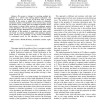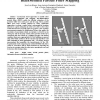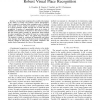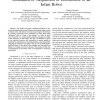86
Voted
ROBIO
2006
IEEE
15 years 6 months ago
2006
IEEE
Abstract— We present a strategy for resolving multiple hypotheses of a robot’s state during global localization. The strategy operates in two stages. In the first stage a uniq...
109
Voted
IROS
2006
IEEE
15 years 6 months ago
2006
IEEE
- This paper presents a three-layer model for generation and recognition of attention-drawing behavior. The model enables a robot to recognize people’s attention-drawing behavior...
112
click to vote
IROS
2006
IEEE
15 years 6 months ago
2006
IEEE
– The limited power, low radio range, and an ever changing environment make the ability to explicitly communicate between multi-robots decreases in a searching task. When this ha...
131
Voted
IROS
2006
IEEE
15 years 6 months ago
2006
IEEE
– In Bayesian based approaches to mobile robot simultaneous localization and mapping, Rao-Blackwellized particle filters (RBPF) enable the efficient estimation of the posterior b...
158
Voted
IROS
2006
IEEE
15 years 6 months ago
2006
IEEE
— An important competence for a mobile robot system is the ability to localize and perform context interpretation. This is required to perform basic navigation and to facilitate ...
94
Voted
IROS
2006
IEEE
15 years 6 months ago
2006
IEEE
117
click to vote
IROS
2006
IEEE
15 years 6 months ago
2006
IEEE
— The goal of this paper is to present an overview of robust estimation techniques with a special focus on robotic vision applications. In this particular context, constraints du...
111
Voted
IROS
2006
IEEE
15 years 6 months ago
2006
IEEE
— We present an on-line, robust, and efficient path planner for the redundant Mitsubishi PA-10 arm with 7 degrees of freedom (DOF) in non-stationary environments. Because of the...
121
Voted
IROS
2006
IEEE
15 years 6 months ago
2006
IEEE
Abstract— The authors proposed a simulation method to clarify the developmental process of human locomotion using a model of infant robot. The infant robot has many degrees of fr...
124
Voted
IROS
2006
IEEE
15 years 6 months ago
2006
IEEE
— We present a robust strategy for docking a mobile robot in close proximity with an upright surface using optical flow field divergence. Unlike previous approaches, we achieve...




